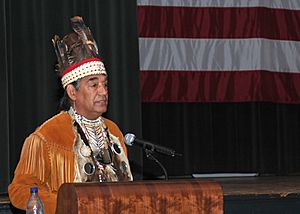Meherrin facts for kids

Chief Thomas "Two Feathers" Lewis of the Meherrin Tribe speaks at a United States Navy function in Norfolk, Virginia in 2008
|
|
| Total population | |
|---|---|
| 900 | |
| Regions with significant populations | |
| Virginia, North Carolina | |
| Languages | |
| English, formerly Iroquoian Meherrin | |
| Religion | |
| Christianity, Longhouse Religion | |
| Related ethnic groups | |
| Tuscarora Nation, Nottaway Tribe, Coree Indians |
The Meherrin Nation calls itself Kauwets'a:ka, which means "People of the Water." They are one of seven state-recognized Native American nations in North Carolina. The Meherrin people live in the countryside of northeastern North Carolina. Their land is near the Meherrin River on the border of Virginia and North Carolina.
Long ago, this Iroquoian tribe lived in the Piedmont area of Virginia. In the early 1700s, they moved south. This was because British colonists were moving onto their traditional lands.
In the early 1700s, the Meherrin were given a special area of land called a reservation. This land was in Hertford County, North Carolina. But over time, they lost most of this land to new settlers. The Meherrin people kept their culture strong by having their own churches and schools. In the late 1900s, the community came together again. They set up their own government. In 1986, the state of North Carolina officially recognized the Meherrin Nation. Today, there are over 900 people enrolled in the Meherrin Nation. Since 1994, the tribe has been asking the United States government to recognize them as a federally recognized tribe.
Contents
Meherrin History and Culture
The Meherrin are a Native American tribe that traditionally spoke an Iroquoian language. This language connects them to the Iroquois League far north in New York. The Iroquois League was a powerful group of tribes around the Great Lakes. Today, most Meherrin people speak English as their first language.
The Meherrin are also related to the Tuscarora. The Tuscarora were another Iroquoian tribe living nearby in Carolina. After a difficult war, many Tuscarora moved north to New York in the early 1700s. The Iroquois Confederacy in New York and Pennsylvania were the most well-known Iroquoian people. They were very powerful during the time of the colonists.
Early Life and Movement
When Europeans first arrived, the Meherrin lived in the Piedmont region of Virginia. This area is above the fall line. They moved south into North Carolina in the early 1700s. They did this to avoid problems with British colonists taking their land.
Experts believe the Meherrin, Tuscarora, and Nottoway tribes share a common background. They likely spoke the same or a very similar Iroquoian language. The stories passed down by the Tuscarora also suggest they came from the same ancestors.
Land Disputes and Conflicts
In 1705, the Virginia Colony set aside a reservation for the Meherrin. This land was called Maherrin Neck. Both Virginia and Carolina claimed this area. Eventually, it was given to Carolina. In 1706, Carolina told the Meherrin to leave their territory. They even threatened to use force. The Meherrin asked for more time to harvest their crops. They also asked Virginia colonists for help.
Virginia supported the Meherrin. But in August 1707, a Carolina official named Thomas Pollock led 60 men to attack Meherrin Town. They destroyed homes, crops, and belongings. Virginia's leaders were very upset. In September, the Virginia militia met with Meherrin chiefs. They promised to protect the Meherrin from Carolina. By 1707, the Meherrin had moved to land once used by the Chowanoke tribe. This land was near the mouth of the Meherrin River.
From 1711 to 1712, the Meherrin joined the Tuscarora in a war against British colonists. This was called the Tuscarora War. In 1713, the Meherrin gave two sons of their main chief as hostages. These boys stayed at the College of William & Mary in Williamsburg, Virginia. This was to make sure the Meherrin would keep the peace. In 1720, the Meherrin made a peace agreement with the Susquehanna, another Iroquoian tribe.
Reservation Changes
In 1717, the Meherrin were given a new reservation. It was along the western side of the lower Chowanoc River. This was near modern Colerain in Bertie County, North Carolina. At first, Governor Charles Eden thought the reservation was 10,000 acres. But a surveyor later found it was more than 40,000 acres.
In 1723, the Virginia Colony confirmed the Meherrin's right to their reservation land. They strongly criticized North Carolina for taking Meherrin land illegally. After the Tuscarora War, many Tuscarora were killed or captured. North Carolina leaders looked at requests from both the Meherrin and British colonists living on their land. By 1726, the Meherrin reservation was much smaller. It was moved to old, empty fields once used by the Chowanoke. But the Province of North Carolina officially agreed in a treaty that this land belonged to the Meherrin.
Modern Meherrin Nation
The Meherrin people have lived in strong, separate communities for many years. They kept their own schools and churches. These helped them keep their identity as a people. In 1975, Meherrin descendants came together again. They reorganized the tribe and brought back its identity. This was led by Chief Wayne Brown. The tribe officially became a group in 1977. This happened after more members became active in their community. The state of North Carolina recognized them in 1986. Many Meherrin people can trace their family history back to Sally M. Lewis (1838–1904). She sold several parts of the reservation land.
The main office for the Meherrin tribe is in Winton, North Carolina. Most of the Nation's people live in the "Little California/Pleasant Plains/Union" area of Hertford County, North Carolina. Many Meherrin people have college degrees. They work in many different professional jobs.
Related Iroquoian Peoples

